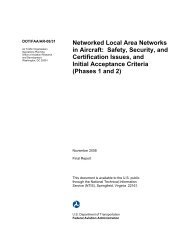Published Report (DOT/FAA/CT-94-36)
Published Report (DOT/FAA/CT-94-36)
Published Report (DOT/FAA/CT-94-36)
Create successful ePaper yourself
Turn your PDF publications into a flip-book with our unique Google optimized e-Paper software.
The Technical Observers believe that consideration should also be<br />
given to rotating new controllers into the simulations. Reaction<br />
time could be affected due to their familiarity of the process, We<br />
believe that half of the controller work force should be new to<br />
each simulation.<br />
Communications between the simulator pilots and the controllers<br />
was a factor as the TCV statements will reflect. The pilots flying<br />
the simulators may have flown for a particular carrier for a long<br />
period of time but during the simulation they were assigned another<br />
carrier call sign. This resulted in a missed communication and<br />
possibly a TCV. Data will be reviewed to determine if this was<br />
actually the case. There were other problems associated with<br />
communications between the controllers and the pseudo pilots due<br />
to inexperience of the pseudo. These problems were discussed as<br />
practical on an individual basis and should be considered when<br />
evaluating simulation results.<br />
Aircraft types and performance characteristics were always a<br />
concern to the controller during a blunder situation. These<br />
concerns seemed to be amplified when a lower performance aircraft<br />
was involved and on the center runway approach. Although a TCV may<br />
not have resulted due to this situation, the Technical Observers<br />
suggest that lower performance aircraft be assigned runway 16L at<br />
DVX when practical because of the additional space between runways.<br />
This would allow more time for the lower performance aircraft to<br />
evade should it become necessary.<br />
CONCLUSION<br />
The Technical Observers agree that triple simultaneous approaches<br />
at the DVX airport can be safely accomplished using the 4.8 second<br />
update radar and the Final Monitor Aid (FMA).<br />
u- c-Dco3;fLm.L<br />
Richard B. Herschmann<br />
SATCS, IAH AT<strong>CT</strong><br />
Chester W. Anderson<br />
Special Projects Officer<br />
AGL-507<br />
boel A. Forrest<br />
SATCS, ATL AT<strong>CT</strong><br />
1-2<br />
W alrace/F .- Watson<br />
ATM, HSV AT<strong>CT</strong>

















